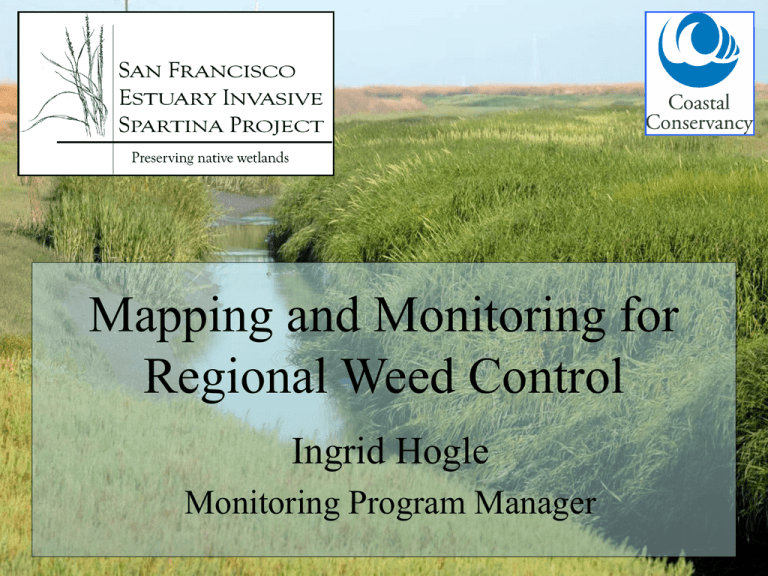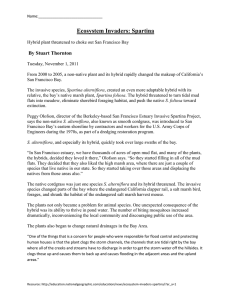San Francisco Estuary Invasive Spartina Project
advertisement

Mapping and Monitoring for Regional Weed Control Ingrid Hogle Monitoring Program Manager Outline • Goal of Spartina Monitoring Program • History of Spartina Monitoring – Workflow – Methods • Update on Monitoring – Patch-level Treatment Surveys – End Game Monitoring Program Goals • Monitor invasive Spartina locations and extent over time • Monitor treatment effectiveness • Provide information to ISP Control Program Monitoring Program Tasks • • • • Inventory mapping Genetic testing Treatment efficacy monitoring Photo point monitoring 2006 2007 2008 Monitoring Program Products • • • • GIS maps and tools for preparation & planning GPS data for field use Genetic results Annual reports Annual Workflow 1. 2. 3. 4. 5. 6. 7. Monitoring Design Spatial Data Preparation/Collection Processing Viewing Editing Map production Decision support Monitoring Design • Annual Inventory – New Features Every Year – Points, Lines & Polygons – Aerial Photo Interpretation – Spatial Grid • Annual Sampling – Permanent Plots Spatial Data Collection Equipment • Handheld GPS units • ArcPad or TerraSync Software • Rubber Boots • Bicycles • Kayaks • Power boats • Airplane or • Helicopter! Spatial Data Collection Methods • Customized data dictionaries • Points, lines & polygons • Grid cells The Past • • • • Extended tidal range Longer, wider leaves Longer, fatter inflorescences This is Taller easy! Invasive Spartina alterniflora x foliosa hybrid Native Spartina foliosa ArcPad Data Check Out ArcPad Data Check Out ArcPad Project on GPS Unit Map Production • Interactive map (used in house…a LOT) • Field maps (to inform monitoring) • Reporting maps (to share with partners, others) Decision Support • Maps • Lab results • Summary data Aerial Photo Interpretation Control Program 2006 2007 2008 Not so easy anymore, huh? The Present • All obvious plants sprayed 2+ years • Regrowth stunted by herbicide • Regrowth may not flower Is this hybrid regrowth, or native? Backcrossing and Introgression native native hybrid hybrid hybrid herbicided hybrid Sanchez Marsh, October 2008 – Laura Feinstein, UC Davis PhD Student 2008 Genetic Testing Monitoring Program Short-Term Future • Expand Patch-level Treatment Surveys • Genetic Test Refinement • Continued Focus on GPS/GIS Information for Control Program Success The Future • Use GPS to guide treatment • Record patch-level treatment effort Spray this one! Monitoring Program Long-Term Future • Field Surveys 3 yrs Absence Data • Remote Sensing • Coordinated Early Detection & Rapid Response View Data in ArcCatalog Workgroup Geodatabase View Data in ArcMap View Data in ArcMap View Data in ArcMap Data Editing: Individual edit maps Data Editing: Columns to record how, what, by whom and when edits were made Reporting Maps Reporting Maps Where to Treat What to Treat: Lab Results Legend: Genetic Results " h )"! g )® "h g )® )"! "))! Confirmed S. foliosa S. foliosa lab ID, other spp field ID S. foliosa lab ID, unknown spp field ID Confirmed S. alterniflora/hybrid S. alterniflora/hybrid lab ID, unknown spp field ID S. alterniflora/hybrid lab ID, other spp field ID S. alterniflora/hybrid lab ID based on lack of a single S. foliosa marker How Much to Treat Questions? THANK YOU ISP Project Director – Peggy Olofson ISP Project Manager – Maxene Spellman ISP Field Operations Managers – Erik Grijalva & Drew Kerr ISP Clapper Rail Monitoring Program Manager – Jen McBroom ISP Office Administrator – Stephanie Erikson ISP Field Staff – Tripp McCandlish, Ode Bernstein, Jude Stalker, Jeff Lewis, Jeanne Hammond, Whitney Thornton, Vicki Trabold, Stephanie Chen, Allison Nelson, Johanna Good Funders – California State Coastal Conservancy, CALFED







